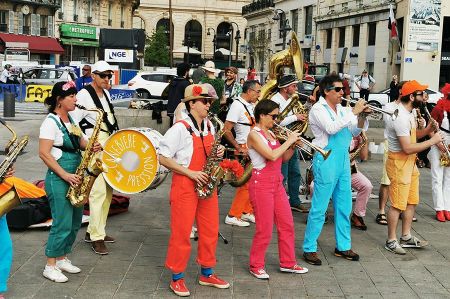Busking – a little stopover at the port of Marseille
- Written by Portal Editor
As in many cities, street music in Marseille re-established itself as a form of cabaret for the general public in the last decades of the 20th century.
So, during our first exploration of the Vieux Port harbour, we weren't particularly surprised to come across various street musicians in the form of soloists and/or groups who were selling their art in the wonderful weather. We found a brass group called Fanf'Phoceennes particularly attractive, all dressed in colourful dungarees with white shirts, who performed an introductory serenade for the upcoming Fanfare Sound Festival on May 3rd and 4th, 2024. With a lot of momentum in rhythm and movement, numerous listeners quickly gathered and the audience even began to encourage dancing.
Street music – help with financing your own life
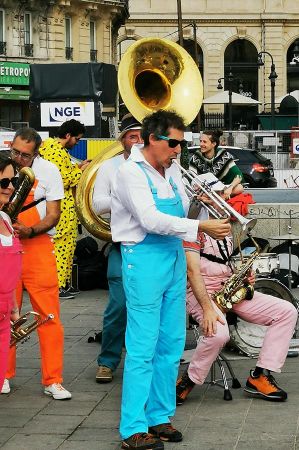 However, street musicians or bards have existed at least since early antiquity, as is known from the itinerant singers of the pre-Homeric period and especially from ancient Iran. The earliest mention of Celtic bards is found in Diodorus Siculus and Strabo, who mention them along with the Druids. Poseidonius sees the bards as courtiers of the Celtic princes and compares them with the Greek rhapsodes. The bards appear primarily as poets, singers, musicians (on the "krotta" or lyre) and praises; their exact relationship to druids and fathers remains obscure.
However, street musicians or bards have existed at least since early antiquity, as is known from the itinerant singers of the pre-Homeric period and especially from ancient Iran. The earliest mention of Celtic bards is found in Diodorus Siculus and Strabo, who mention them along with the Druids. Poseidonius sees the bards as courtiers of the Celtic princes and compares them with the Greek rhapsodes. The bards appear primarily as poets, singers, musicians (on the "krotta" or lyre) and praises; their exact relationship to druids and fathers remains obscure.
However, the authors agree that the bards did not have the right to sacrifice to the gods, which is why they do not belong to the priestly class. The Greek philologist Hesychios of Alexandria writes: "The bards are the singers of the Galatians", i.e. the Celts, and the Roman grammarian Sextus Pompeius Festus says of them: "The Gauls call bards the singer who sings the praises of brave men."
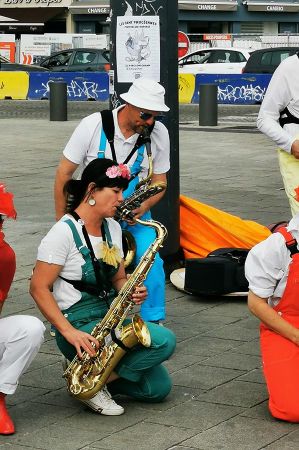 The bard Ossian from James Macpherson's poem of the same name and the bard Troubadix as a comic character in the Asterix series by René Goscinny and Albert Uderzo became known from literature. In other cultures, as we were able to experience at the organ grinder festival in Nauenburg, professions that correspond to the function of earlier street musicians have long been known, even if their songs often correspond more to folk songs.
The bard Ossian from James Macpherson's poem of the same name and the bard Troubadix as a comic character in the Asterix series by René Goscinny and Albert Uderzo became known from literature. In other cultures, as we were able to experience at the organ grinder festival in Nauenburg, professions that correspond to the function of earlier street musicians have long been known, even if their songs often correspond more to folk songs.
Street music is mostly performed by instrumentalists or singers, and occasionally by solo entertainers, and the range is extremely wide. When the musicians perform alone instead of as a small group, they sometimes use recordings for the accompanying music, as we were able to experience the saxophonist in Marseille, who showed off his skills a few hundred meters away. The saxophonist had set up a spot at the harbour basin and presented his solo, for which he indirectly asked passers-by for money, which was usually placed in a hat or in the instrument case by the listeners.
These street musicians are often music students or young people on the road who use this method to finance part of their travel costs. Occasionally, the musicians later develop into popular artists, such as some rappers or, for example, the Brazilian Emboladas.
Street musicians with artistry and clowning
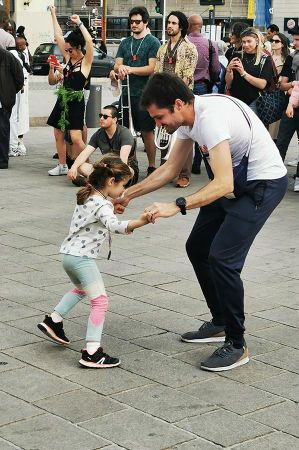 Street music is often performed together with other art forms such as juggling, artistry, clowning and the like.
Street music is often performed together with other art forms such as juggling, artistry, clowning and the like.
Street musicians often work to gain greater skill with their instrument when they can hardly hope to get involved in the scene - like young jazz musicians or students at a music academy. In addition to the possibility of earning an income, many street musicians are interested in practicing their skills, but also in gaining experience with a neutral audience.
Getting to know the music scene and becoming well-known is also a possible goal.
Some musicians also live their dream or their contribution to social movements and grassroots democratic confrontation with oppression.
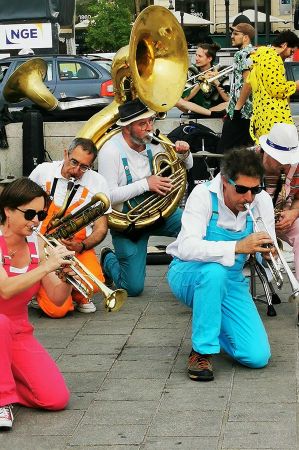 Political motives motivated many songwriters in the 1970s and 1980s to perform their songs to passers-by, to create a counter-public for socially critical content and, if necessary, to take part in demonstrations and strikes.
Political motives motivated many songwriters in the 1970s and 1980s to perform their songs to passers-by, to create a counter-public for socially critical content and, if necessary, to take part in demonstrations and strikes.
Street music is particularly popular with alternative travellers who use street music to cover the costs of their travel and meals.
Music students from Eastern European countries regularly use street music to finance their studies by busking in wealthier countries and thus getting to know the country and society at the same time.
Many young people also take on the role of street musicians in order to earn part of their travel costs.
Public places with a lot of public traffic
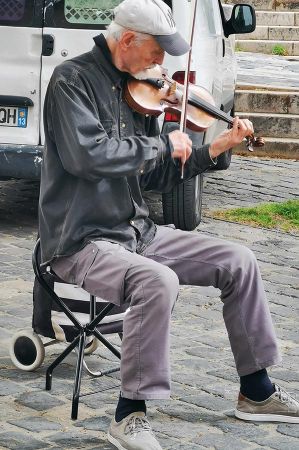 Street musicians are occasionally referred to when the artistic level is less high. We have often heard the absolute opposite, whether in Thessaloniki, Berlin or now in Marseille.
Street musicians are occasionally referred to when the artistic level is less high. We have often heard the absolute opposite, whether in Thessaloniki, Berlin or now in Marseille.
A typical street musician of earlier decades was the barrel organ player, as already mentioned, who sometimes encouraged amateur singers to join in at the lecture site.
In the meantime, this form of music has been replaced by guitarists or accordion players at subway stations etc., but also by various woodwind and brass players and artists on the Jew's harp.
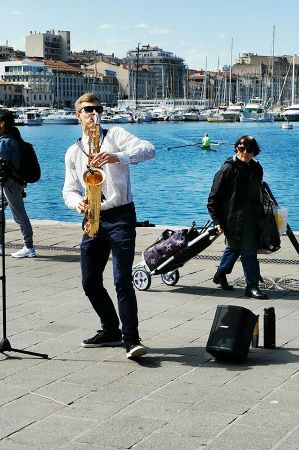 Street musicians understandably prefer busy places, for example public places like the Vieux Port, but also shopping streets, pedestrian zones, tourist attractions or even public transport. Subway stations, periodic street markets and parks, which are popular in the summer months, are also popular. There are also spontaneous or organized festivals for street artists. Most street musicians are instrumentalists who often play several musical instruments.
Street musicians understandably prefer busy places, for example public places like the Vieux Port, but also shopping streets, pedestrian zones, tourist attractions or even public transport. Subway stations, periodic street markets and parks, which are popular in the summer months, are also popular. There are also spontaneous or organized festivals for street artists. Most street musicians are instrumentalists who often play several musical instruments.
We particularly liked the performances of the fanfare group, but also the soloist on the saxophone. And ultimately, it's good to just pause for a few minutes when otherwise even the exploration doesn't allow much interruption.
Please read as well:
Street Art – Colourful Quartier du Panier
Legends and founding myth about the city of Marseilles
-
 Street Musicians in Marseille performing
Street Musicians in Marseille performing
Street Musicians in Marseille performing
Street Musicians in Marseille performing
-
 Street Musicians in Marseille performing
Street Musicians in Marseille performing
Street Musicians in Marseille performing
Street Musicians in Marseille performing
-
 Street Musicians in Marseille performing
Street Musicians in Marseille performing
Street Musicians in Marseille performing
Street Musicians in Marseille performing
-
 Street Musicians in Marseille performing
Street Musicians in Marseille performing
Street Musicians in Marseille performing
Street Musicians in Marseille performing
-
 Street Musicians in Marseille performing
Street Musicians in Marseille performing
Street Musicians in Marseille performing
Street Musicians in Marseille performing
-
 Street Musicians in Marseille performing
Street Musicians in Marseille performing
Street Musicians in Marseille performing
Street Musicians in Marseille performing
-
 Street Musicians in Marseille performing
Street Musicians in Marseille performing
Street Musicians in Marseille performing
Street Musicians in Marseille performing
-
 Street Musicians in Marseille performing
Street Musicians in Marseille performing
Street Musicians in Marseille performing
Street Musicians in Marseille performing
-
 Street Musicians in Marseille performing
Street Musicians in Marseille performing
Street Musicians in Marseille performing
Street Musicians in Marseille performing
-
 Street Musicians in Marseille performing
Street Musicians in Marseille performing
Street Musicians in Marseille performing
Street Musicians in Marseille performing
-
 Street Musicians in Marseille performing
Street Musicians in Marseille performing
Street Musicians in Marseille performing
Street Musicians in Marseille performing
-
 Street Musicians in Marseille performing
Street Musicians in Marseille performing
Street Musicians in Marseille performing
Street Musicians in Marseille performing
https://www.alaturka.info/en/culture/music/6617-busking-a-little-stopover-at-the-port-of-marseille#sigProIdef984559fc
